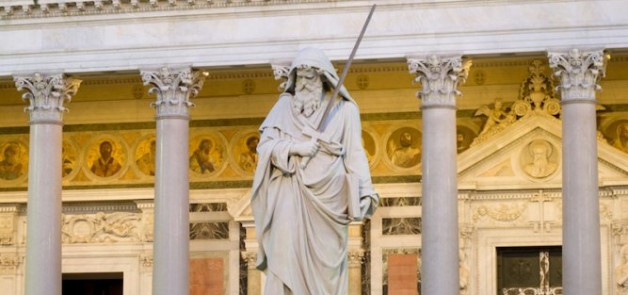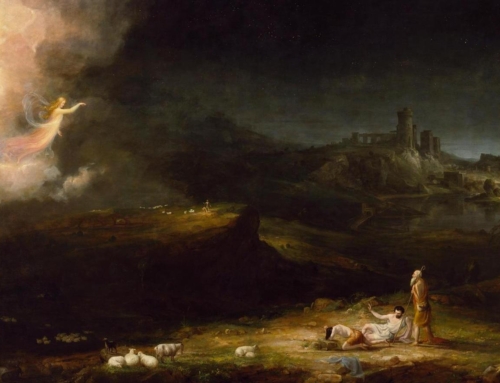In the beginning of the Book of Revelation, there is a vision of heaven. What are the blessed are doing in heaven? Worshipping God, of course. That means liturgy.
We read in Vatican II’s Constitution on the Liturgy, Sacrosanctum Concilium, that
the liturgy is the summit toward which the activity of the Church is directed; at the same time it is the font from which all her power flows (§ 10). In the earthly liturgy we take part in a foretaste of that heavenly liturgy which is celebrated in the holy city of Jerusalem toward which we journey as pilgrims, where Christ is sitting at the right hand of God, a minister of the holies and of the true tabernacle (§8).
What is the most basic, unalterable outline of the Mass? The word of God, followed by the sacrifice of Jesus, the Lamb of God. This is the very first thing we see in the Book of Revelation, in Chapters 1-5: Jesus gives St. John seven letters for the Churches, and then the Lamb of Sacrifice appears, slain.
The more we know the liturgy of the Church, the more connections we will see. There is the acclamation “Holy, Holy, Holy;” also, in the Communicantes section of the Roman Canon there are twelve Apostles and twelve martyrs, for a total of twenty-four “elders;” there are seven readings in the Easter Vigil, corresponding to the seven letters; the altars, incense, sacred vessels, vestments, and intercessory prayer likewise have analogues in Revelation.
The outward signs of the Mass resemble the signs of the heavenly liturgy in the Book of Revelation for a very important reason: to show that the invisible spiritual realities they signify are the same. The Mass on earth is a foretaste of and participation in the liturgy of heaven (For more information on the topic, see Scott Hahn’s fine and very accessible book The Lamb’s Supper: The Mass as Heaven on Earth).
In chapter 1 of the Book of Revelation, Jesus appears to St. John, and his appearance is similar to the Transfiguration in the Gospel and the Son of Man theophany in Daniel. In addition St. John sees in the vision a “sharp two-edged sword” coming out of Jesus’ mouth. The traditional interpretation of this symbolic image is that the sword represents the word of God. Keeping in mind what we have learned from the Old Testament prophets about the symbolic nature of prophetic visions, is there a Scriptural passage we can look to in order to see that this is not an arbitrary interpretation forced on the text?
Yes, but we probably won’t recognize it unless we know Scripture quite well. In Judges 3 we read,
Ehud made himself a two-edged dagger a foot long, and strapped it under his clothes on his right thigh… Ehud went in to [Eglon the king of Moab] where he sat alone in his cool upper room. Ehud said, “I have a word from God for you.” So the king rose from his throne. Then Ehud with his left hand drew the dagger from his right thigh, and thrust it into Eglon’s belly.
—Judges 3:16, 20-21
A word from God—in the Hebrew of this passage, literally a “word of God” (דְּבַר־אֱלֹהִים). In the New Testament, Hebrews 4:12 uses a similar image. The Book of Revelation is full of signals like this for those who can read and interpret them.
Notice that the book tells us right up front that the images in it have “secret meanings” (this is the NABRE’s interpretation of “mysterium”—Gr. μυστήριον). It’s not that we keep “secrets” because we’re mean or exclusive. It’s rather that the mysteries themselves only admit those who are able to enter into them, those who participate in the mind of God through the grace of faith, and who know the Scriptures in light of that faith. With this graced knowledge, we can exercise the prophetic discernment needed to understand the mysteries of the Book of Revelation.
The traditional interpretation of Revelation 1:20 is that the “angels of the seven churches” means the pastors, or the bishops of the seven churches. This is not a symbolic interpretation, as though angel-spirits symbolically stand for human priests, but the plain-language explanation of the image. Because the word we translate as “angel” means “messenger” in both Greek and Hebrew, the Scriptures in those languages use their words for “angel” to signify messenger-humans and messenger-spirits alike without distinction. In addition, ecclesiastical authors from the Fathers to the present day have called priests “angels,” often citing Malachi 2:7. This is how St. Bede interprets this passage. The old Catholic Encyclopedia and the Haydock commentary take this as uncontroversial. For other examples of priests being called angels, see for example St. Ambrose On the Mysteries Chapter 2, St. John Chrysostom On the Priesthood Book III Chapter 4, St. Thomas Aquinas Summa Theologiae III, q. 22, a. 1 ad 1, who cites Pseudo-Dionysius (Coel. Hier. 9), and Pope Leo XIII Encyclical on the Clergy in Brazil 1894.
Now let’s look at one of the letters.
To the angel of the church in Pergamum, write this:
“The one with the sharp two-edged sword says this: ‘I know that you live where Satan’s throne is, and yet you hold fast to my name and have not denied your faith in me, not even in the days of Antipas, my faithful witness, who was martyred among you, where Satan lives. Yet I have a few things against you. You have some people there who hold to the teaching of Balaam, who instructed Balak to put a stumbling block before the Israelites: to eat food sacrificed to idols and to play the harlot. Likewise, you also have some people who hold to the teaching of [the] Nicolaitans. Therefore, repent. Otherwise, I will come to you quickly and wage war against them with the sword of my mouth.
Whoever has ears ought to hear what the Spirit says to the churches. To the victor I shall give some of the hidden manna; I shall also give a white amulet upon which is inscribed a new name, which no one knows except the one who receives it.’ ”
—Revelation 2:12-17
Who are the Nicolaitans? The way it’s worded in the above translation it sounds like the teaching of the Nicolaitans is something separate from the teaching of Balaam. That is one way to read the Greek. But verse 15 might just as well be read: “Thus you, too, have some who hold…,” identifying Nicolaitanism with Balaamism, as I think the traditional reading likes to do. This is a reasonable reading because it has St. John describing current events in terms of Scripture, as he does everywhere else in the book, instead of making ordinary descriptions that just anyone could know.
Either way, Nicolaitanism is a perverse doctrine, of the kind covered in Post IX: Balaam shows how sexual immorality, besides being a sin in itself, both symbolizes and leads to abandonment of God for false gods. Thus sexual holiness is the front line of spiritual warfare, the visible part of a vast and high-stakes war between heaven and hell—a war that in this life is invisible except when the veil is drawn back, as in the Book of Revelation. This is why the principal focus of the Angelic Warfare Confraternity is chastity.
At the end of each letter Jesus says, “To the victor… I will give…” and then names several enigmatic gifts. St. Bede says that each of these is a symbolic way of Jesus saying that he will give his very self. This makes sense, both because the gifts are all symbols or prophecies of Christ in the Scriptures, and because we know from faith that the great reward of Christianity—the “hundredfold”—is Jesus himself.
Image: Jeff Geerling, Statue of Paul with Sword at St. Paul Outside the Walls







